Picture this: You slide open the door to your balcony. Instead of a concrete slab, you step into a personal oasis. The air feels a little cleaner, a little quieter. There’s the scent of lavender and basil, the soft rustle of leaves, and a visual tapestry of greens, purples, and reds that instantly calms your nervous system. This isn’t just about having a few pots around; it’s about intentionally designing an extension of your home that serves as an emotional and psychological reset button.
People always ask me how to create that feeling, and they think it’s about having a “green thumb.” It’s not. It’s about understanding that a balcony is a unique ecosystem with its own rules. More importantly, it’s about realizing that every choice—from the color of a pot to the texture of a leaf—sends a subconscious message to your brain. You’re not just growing plants; you’re cultivating a mood. So let’s talk about how to do it right, without the corporate jargon and confusing advice. This is the real story of how to create a balcony that doesn’t just survive, but actively makes your life better.
Planning for Success: Foundations of Your Balcony Garden (Part 1)
Before you even think about buying a single plant, we have to lay the groundwork. This is the part everyone wants to skip, but it’s the difference between a garden that thrives and one that becomes a source of stress and guilt. Think of it like building the foundation of a house. Get this right, and everything else becomes infinitely easier and more enjoyable.
1. Accurately Map Your Balcony’s Daily Sunlight Exposure
You know how people say, “Oh, my balcony gets full sun,” and then wonder why half their plants are scorched and the other half are stretching desperately for light? It’s because they guessed. Your balcony doesn’t have one single light condition; it has multiple micro-zones. That corner might get blasted by the afternoon sun, while the spot by the door only gets a couple of hours of gentle morning light. Ignoring this is like trying to furnish a room without measuring it first.
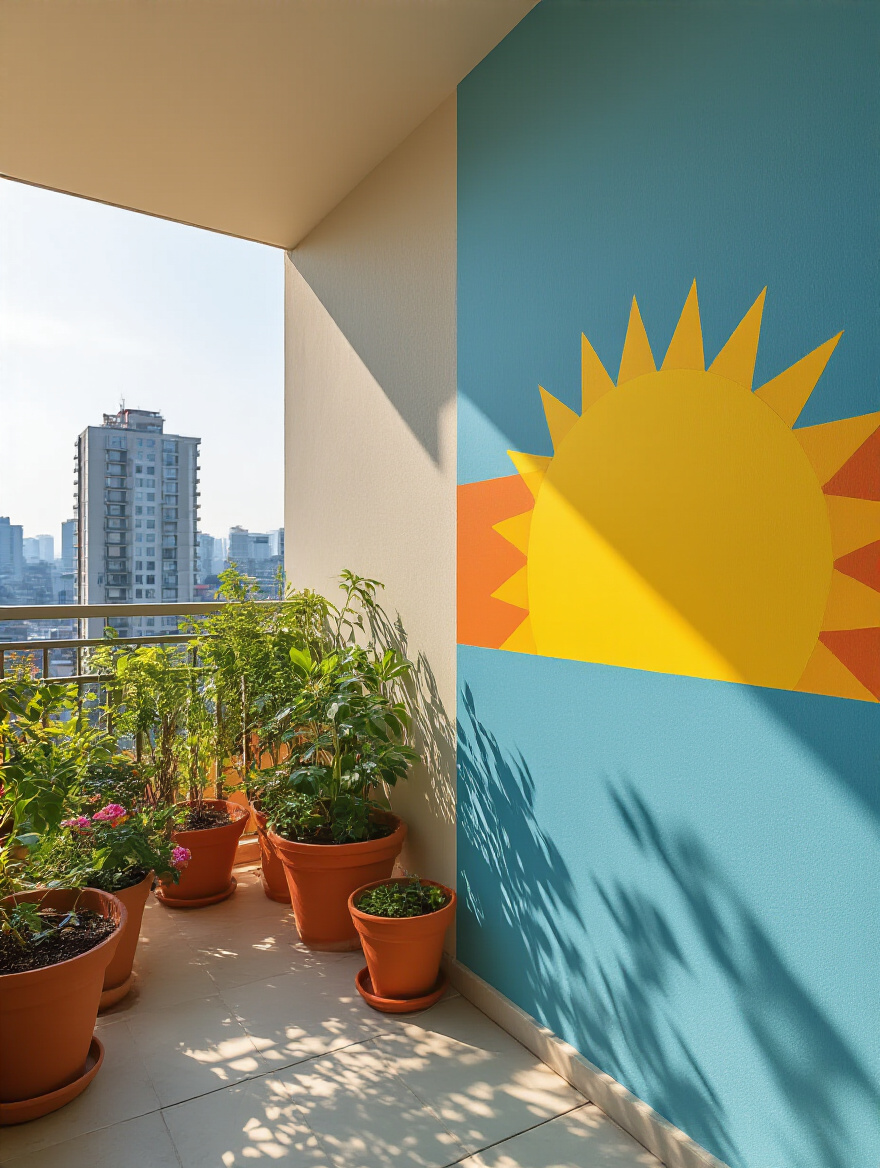
To get this right, you have to play detective for a day. Every hour, take a picture or make a note of where the sun is hitting. I call this creating a “sun map.” You’ll quickly see that the ‘personality’ of your balcony changes dramatically throughout the day. This map becomes your blueprint for everything. Sun-worshipping plants like tomatoes and petunias go in the 6+ hour zones, while shade-tolerant ferns and impatiens will feel safe and calm in the cooler spots. This isn’t just about plant survival; it’s about reducing your own stress by not fighting a losing battle against nature.
This step alone is the secret to moving from a novice to a confident gardener, because you’re starting with the most important piece of information.
2. Confirm Structural Weight Limits for Safe Planter Placement
Okay, this is the serious talk. I once consulted on a project where a client had loaded up their gorgeous but aging balcony with massive, ornate concrete planters. They looked incredible, until a contractor doing unrelated work pointed out the subtle bowing and hairline cracks forming underneath. They had to remove everything, fast. It was a costly and terrifying lesson in physics. You simply cannot ignore the weight your balcony can safely hold.
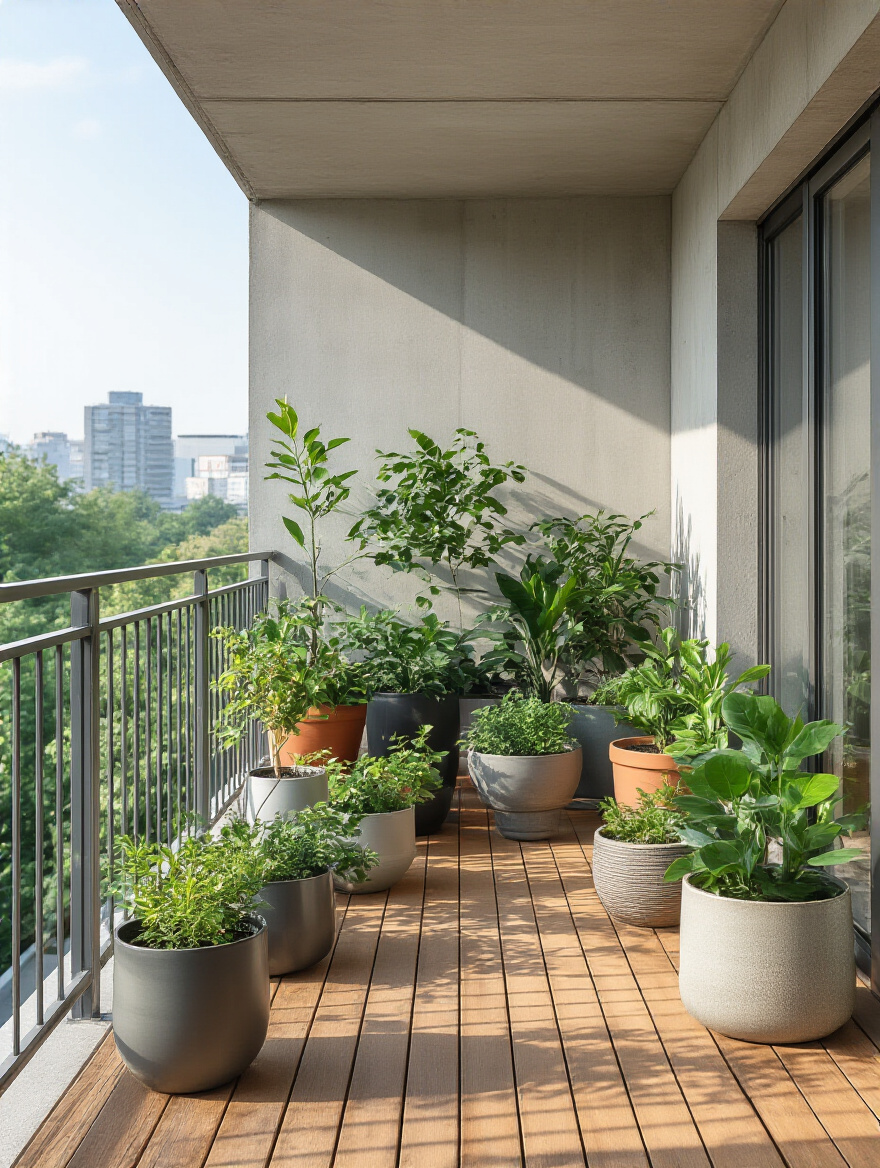
Waterlogged soil is incredibly heavy—a single cubic foot can weigh over 100 pounds. Add the weight of the pot, the plant, and yourself, and you can see how it adds up. So, before you do anything else, you need to find that number. Check your building’s documents, call your landlord, or consult management. Adhering to this limit is a non-negotiable for your safety and peace of mind. Knowing this number doesn’t limit your creativity; it focuses it. It will guide you toward beautiful, lightweight fiberglass or resin planters and lighter soil mixes, ensuring your urban oasis is a place of calm, not a structural liability.
When in doubt, always err on the side of caution and distribute weight, placing heavier pots over load-bearing supports if possible.
3. Select Appropriately Sized and Draining Containers for Plant Health
Can we please debunk a massive myth right now? Putting a layer of gravel or rocks at the bottom of a pot does not improve drainage. It’s one of the most persistent pieces of bad advice out there. In reality, it just raises the water table inside the pot, forcing your plant’s roots to sit in a swampy, oxygen-deprived zone. The only thing you need for good drainage is a pot with actual holes in the bottom and a high-quality potting mix that won’t compact.
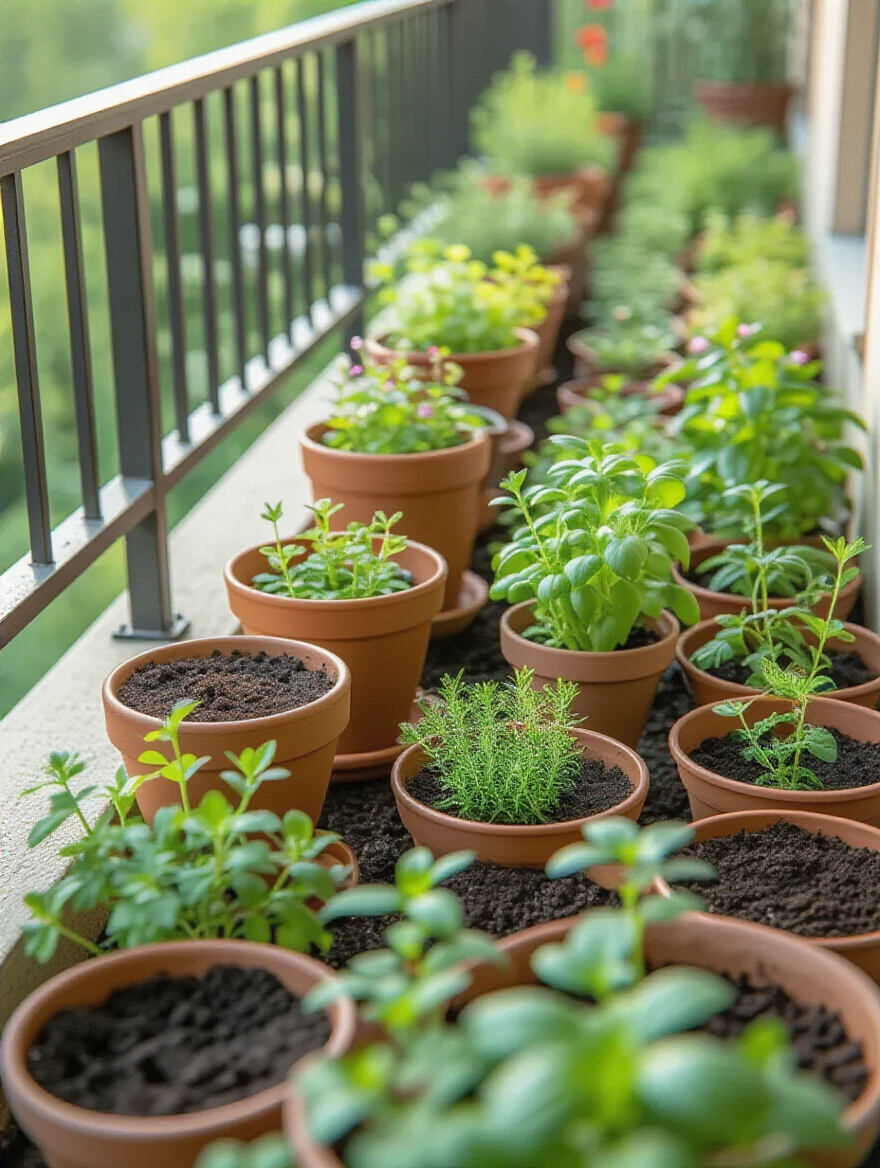
Think of the container as your plant’s home and its outfit. The size and material dictate its long-term health and contribute to your balcony’s overall style. A pot that’s too small will constrict roots, stunting growth and making the plant constantly thirsty. A pot that’s too large holds excess moisture the roots can’t use, inviting rot. The ideal size gives the root ball about 1-2 inches of space to grow. Porous terracotta is fantastic for plants that need to dry out, like rosemary or succulents, because it breathes. Glazed ceramic or plastic is better for moisture-lovers, as it retains water longer.
Choosing the right container is an act of empathy for your plant and a crucial design choice for your space.
4. Assess Your Watering Source Accessibility and Efficiency
Let’s be honest with ourselves. If watering your plants involves hauling a heavy can back and forth through your kitchen ten times, how long are you really going to keep that up? Your garden will quickly become a chore you resent rather than a retreat you enjoy. The design of your garden isn’t just about what it looks like; it’s about how it feels to interact with it. Making watering easy is paramount.
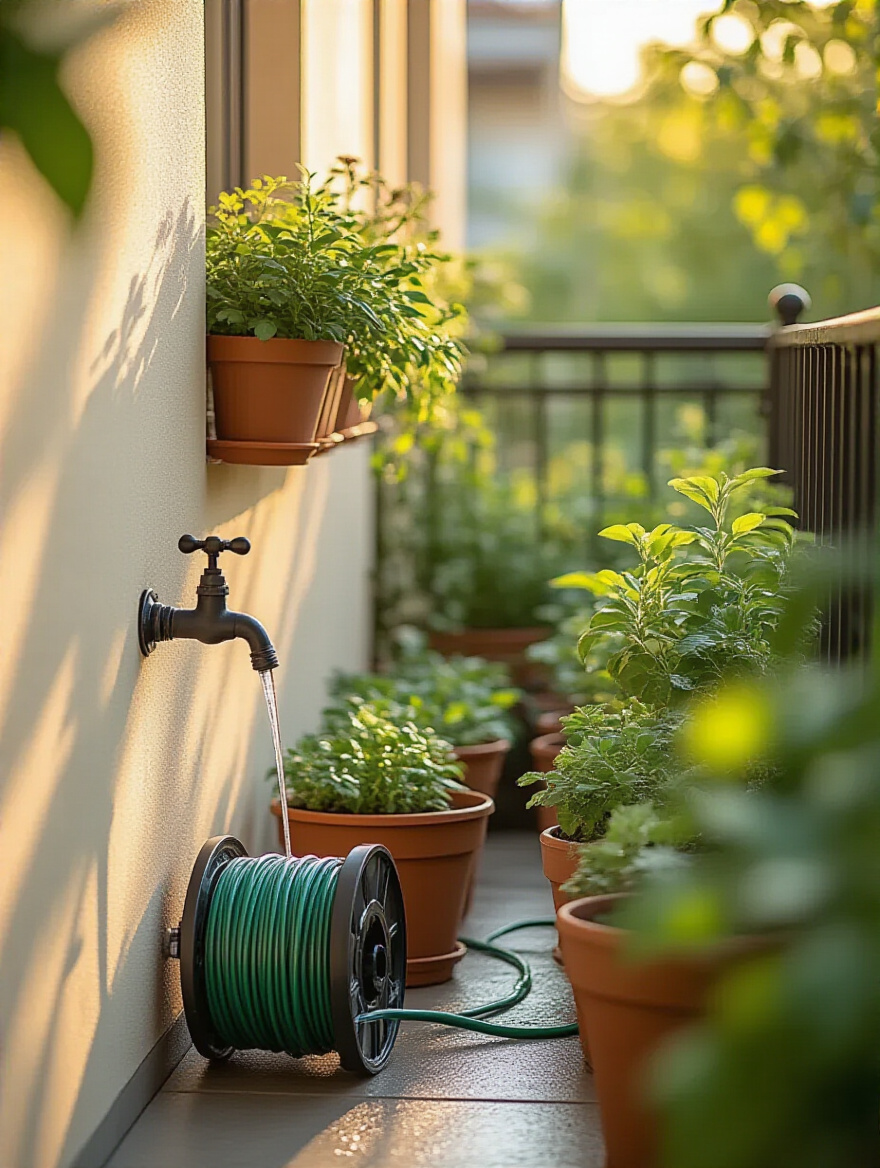
Before you set up a single pot, figure out your water logistics. Do you have an outdoor faucet? Can you attach a compact, coiled hose to your kitchen sink with an adapter? This simple piece of hardware can be a total game-changer, turning a 15-minute slog into a 2-minute task. If a hose isn’t an option, consider investing in a few beautiful, large watering cans or self-watering planters. By planning for convenience from the start, you’re designing a sustainable habit for yourself and ensuring your plants get the consistent hydration they need to thrive.
The goal is to remove friction, so you can spend more time enjoying the space and less time laboring in it.
Planning for Success: Foundations of Your Balcony Garden (Part 2)
Now that we have the un-skippable basics down, we can move into the more creative side of planning. This is where we start blending the science of horticulture with the art of design to create a space that feels intentional, cohesive, and deeply personal.
5. Research Climate-Resilient Plant Species for Local Conditions
I confess: I used to be a victim of impulse-buying plants at the garden center. I’d see a beautiful tropical flower and immediately picture it on my balcony, completely ignoring the fact that I live in a climate with cold winters. After a few heartbreaking (and expensive) failures, I learned my lesson. You have to choose plants that want to live where you are. Fighting your local climate is an exhausting, uphill battle you will eventually lose.
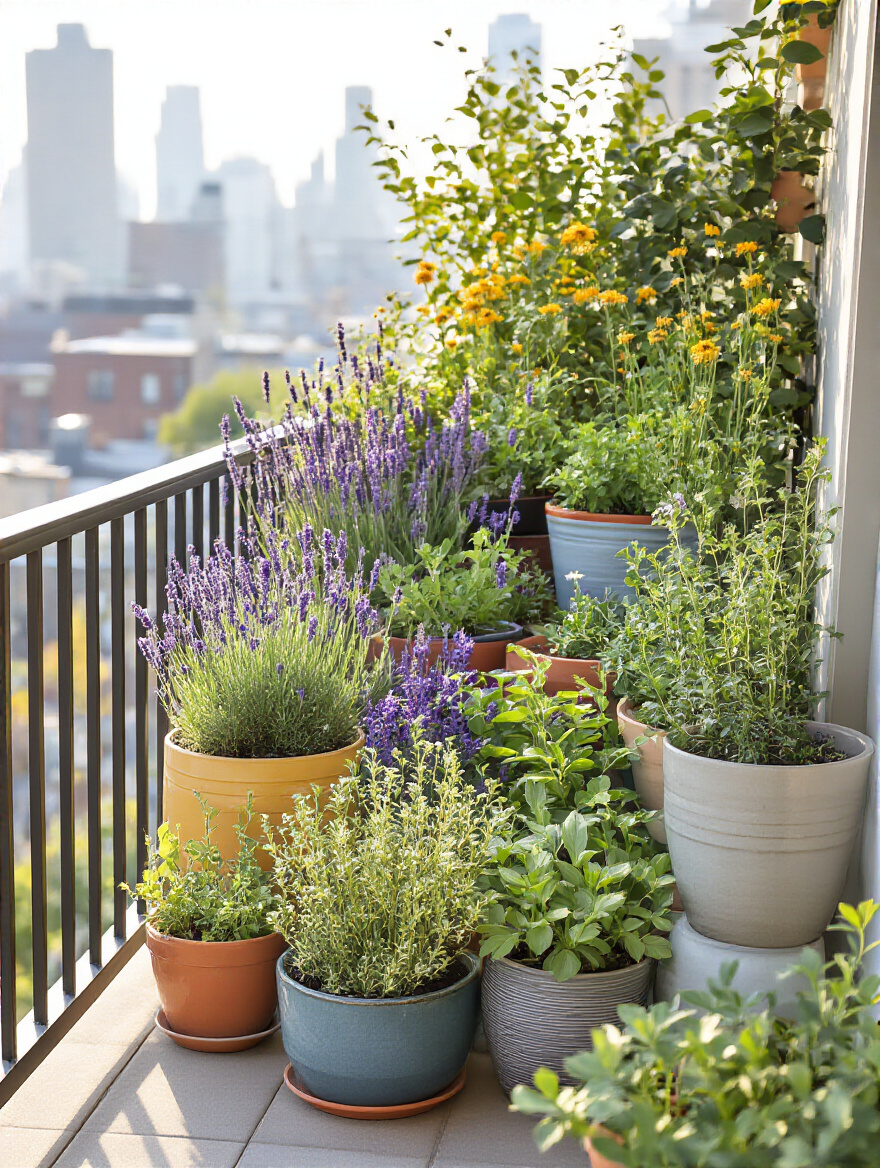
Instead, lean into it. Start by identifying your USDA Hardiness Zone. This tells you which plants can survive your winter temperatures. But then, go deeper. Is your balcony a wind tunnel? Does it get cooked by reflected heat from a neighboring window? These are your unique microclimate conditions. Choosing plants adapted to these challenges—like drought-tolerant succulents for a hot, dry spot or sturdy ornamental grasses for a windy corner—is the ultimate shortcut to success. You’ll use less water, do less work, and have a garden that feels effortlessly lush because you’ve chosen collaborators, not adversaries.
It’s about creating harmony between your vision and the reality of your environment. That harmony is where true beauty lies.
6. Design a Functional Layout Prioritizing Plant Needs and Accessibility
This is where my interior designer brain gets really excited. A balcony garden is a small room, and it needs a floor plan. Randomly placing pots wherever they fit creates visual chaos and makes maintenance a nightmare. A well-designed layout guides the eye, creates a sense of order and flow, and makes caring for your plants a simple, joyful ritual. Before placing anything, sketch it out.
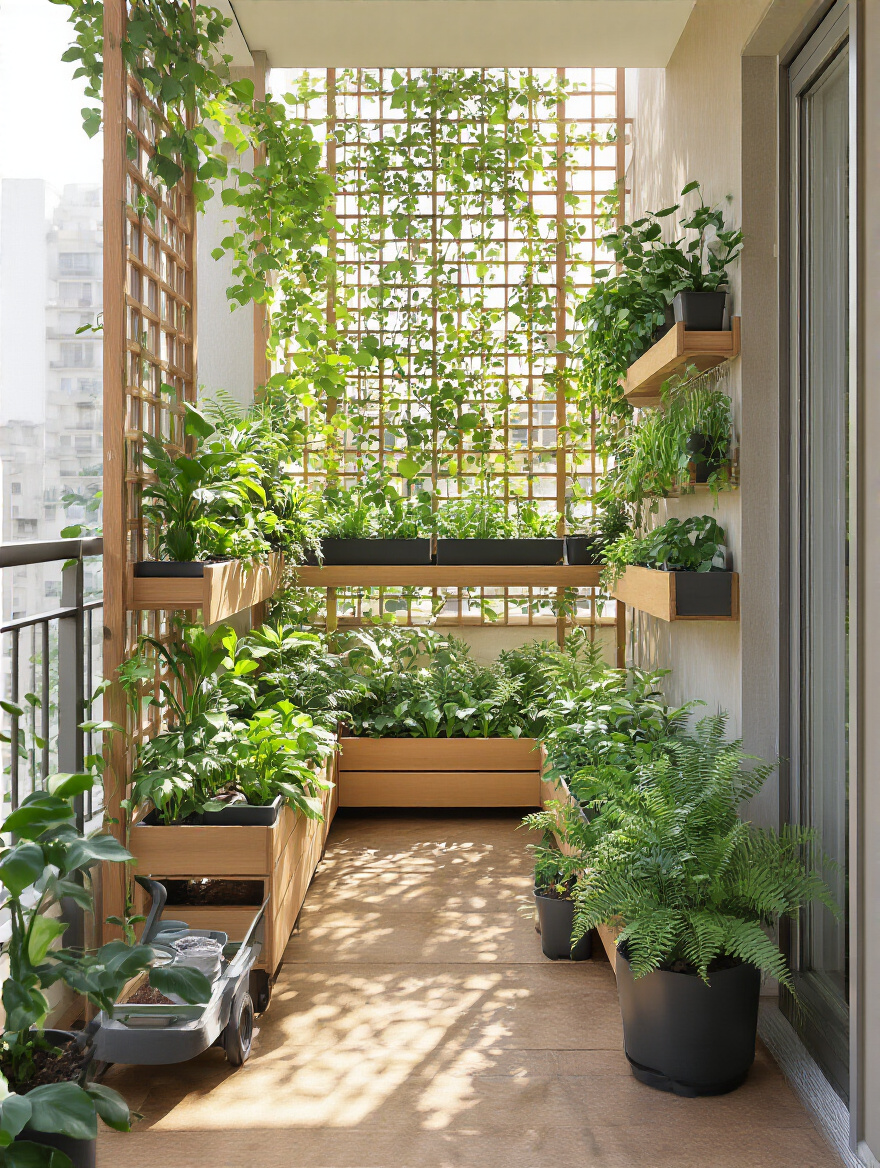
Group plants with similar needs together. Your sun-lovers should live in one “neighborhood,” and your shade-seekers in another. This simplifies watering and care immensely. Think vertically! Use tiered shelves, railing planters, and wall-mounted pots to draw the eye upward and make the space feel larger and more immersive. Most importantly, design clear pathways for yourself. You need to be able to reach every single plant without knocking over five others. I had a client whose garden was so dense they couldn’t reach the back row to water, and those plants inevitably died.
Your layout should serve two clients: the plants and you. When both are happy, the garden will flourish.
Smart Selection & Setup: Bringing Your Balcony Garden to Life (Part 1)
With a solid plan in place, it’s time for the fun part: choosing your plants and getting them settled in their new homes. This is where your vision starts to become a reality. Each choice here builds on the last, setting the stage for a resilient, beautiful, and low-stress garden.
7. Choose Right-Plant, Right-Place Varieties Matching Light & Space
This concept is so important it’s worth repeating from a different angle. After you’ve mapped your sun, you now hold the key to success. This isn’t just about choosing a “sun” or “shade” plant; it’s about being specific. “Partial shade” can mean gentle morning sun or harsh late-afternoon sun, and those are two very different things for a plant. Bringing a plant home is like adopting a pet; you have a responsibility to provide the right environment for it to thrive.

Read the plant tags. They are your instruction manuals. They’ll tell you the light, water, and mature size of the plant. That last part is crucial—that tiny herb will grow, and you need to plan for its future self. Misjudging this is the number one reason balcony gardens become overcrowded jungles. Making the right choice at the nursery prevents so much future heartache and wasted money. You’re not just buying a plant; you’re making a match. A good match leads to a happy, low-maintenance relationship.
This simple act of mindful selection is the most powerful tool you have.
8. Opt for Premium Potting Mixes Engineered for Container Gardens
Here’s a hard truth: using soil from your yard or buying the cheapest bag of “potting soil” at the store is like putting gas-station coffee in a high-end espresso machine. It just won’t work. Garden soil is dense, heavy, and compacts in a pot, suffocating roots. Cheap potting mixes are often not much better, breaking down into a muddy mess that offers no aeration. This is the foundation of your plant’s health, and it’s no place to cut corners.
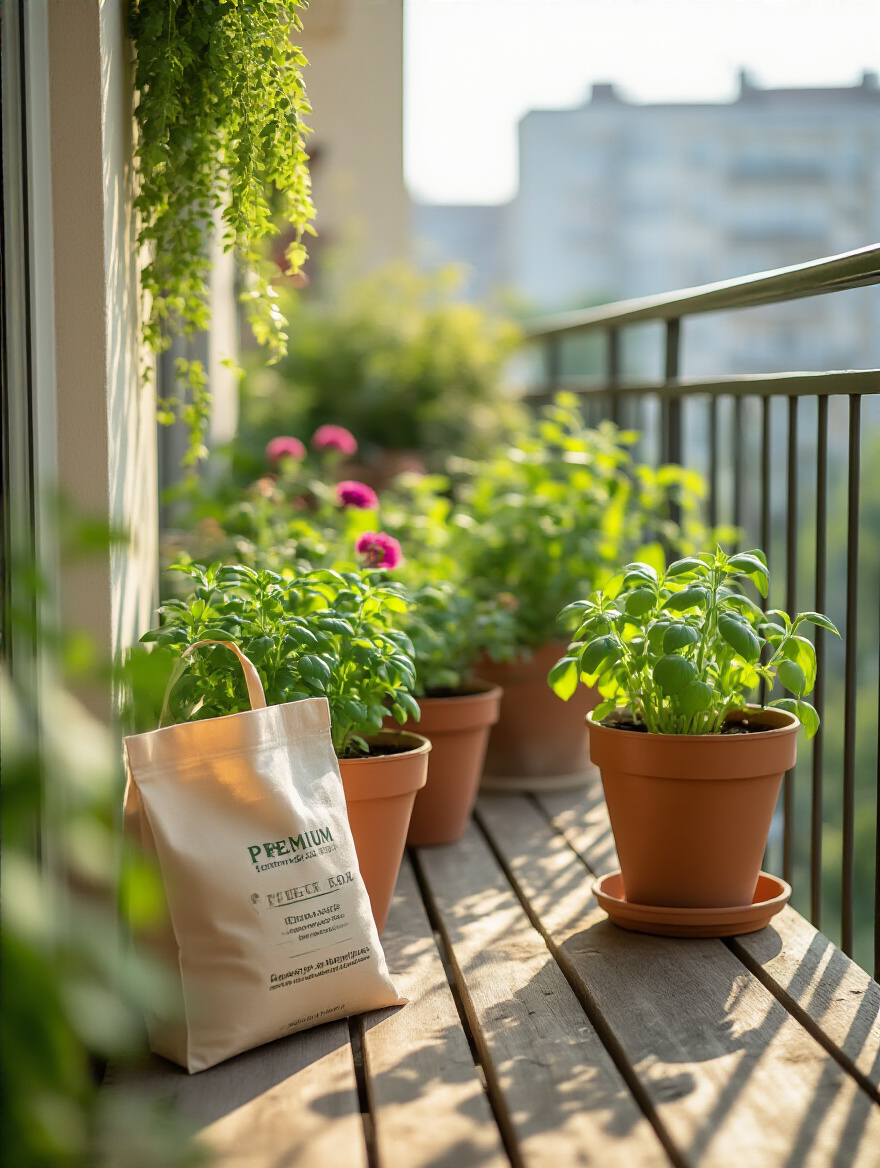
Invest in a premium potting mix specifically formulated for containers. Look for ingredients like peat moss or coco coir for moisture retention, and perlite or vermiculite for lightness and aeration. This fluffy, well-draining medium is the five-star hotel your plant’s roots deserve. It holds the perfect balance of air, water, and nutrients, creating an environment where roots can grow strong and healthy. It may cost a little more upfront, but it pays for itself tenfold in plant health, preventing issues like root rot before they can even start.
Think of it this way: you are building your plant’s entire world inside that pot. Make it a good one.
9. Ensure Adequate Drainage Solutions to Prevent Root Rot
I cannot say this enough: the number one killer of container plants is overwatering, which is almost always caused by poor drainage. A plant’s roots need to breathe. When they sit in waterlogged soil, they run out of oxygen and begin to rot. It’s a silent killer, and by the time you see the symptoms (yellowing leaves, wilting), it’s often too late. Every single pot you own must have drainage holes. No exceptions.
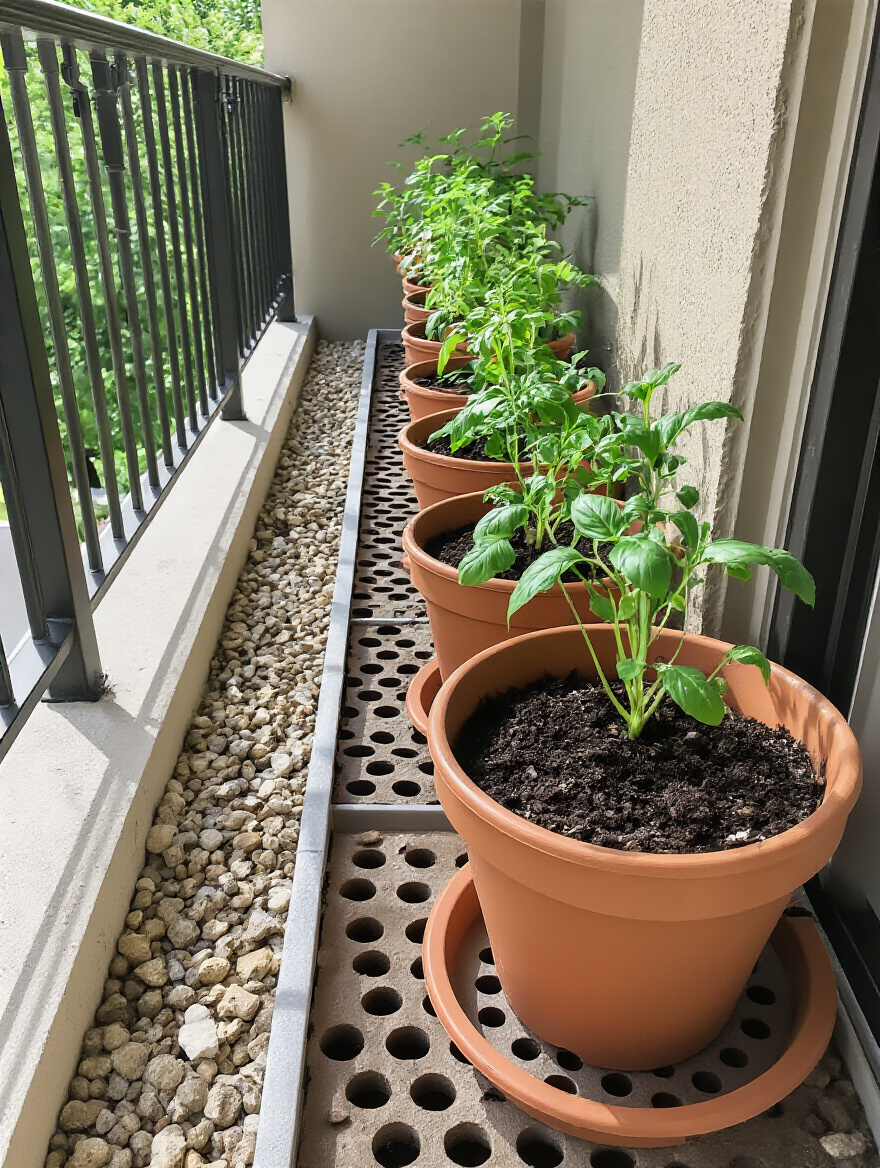
If you fall in love with a decorative pot that doesn’t have a hole, you have two options: drill one yourself (it’s easier than you think with the right drill bit) or use it as a “cachepot.” This means you keep your plant in its cheap plastic nursery pot (which has great drainage) and simply place it inside the decorative one. When you water, take the inner pot out, let it drain completely, and then put it back. This gives you the best of both worlds: great aesthetics and perfect drainage.
Proper drainage is the single most important factor for the health of your balcony plants. Don’t compromise on it.
10. Install Efficient Watering Systems for Consistent Moisture
During the peak of summer, a balcony can be a brutal environment. Pots heat up and soil can dry out in a matter of hours. If you have a busy life or plan to travel, relying on manual watering can be a recipe for disaster. This is where a little technology can bring a lot of peace of mind. An automated watering system isn’t lazy; it’s a smart, strategic tool for ensuring the consistency that plants crave.
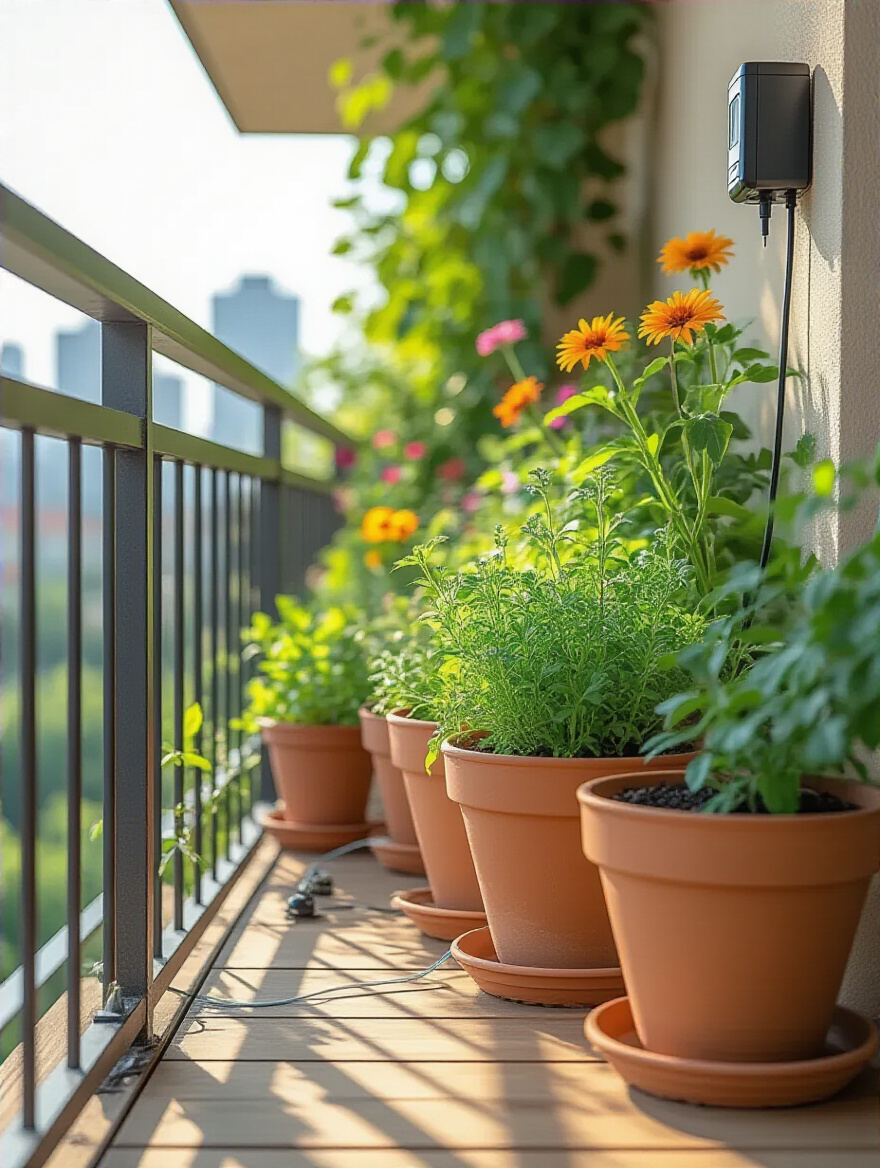
For a few pots, self-watering planters with built-in reservoirs are brilliant. For a larger collection, a simple drip irrigation kit is revolutionary. You can get a starter kit online or from a hardware store for a surprisingly low price. It consists of thin tubing that runs from pot to pot, with little emitters that drip water slowly and directly onto the soil. Hook it up to a simple battery-powered timer, and your watering is done. You’ll use less water, your plants will be happier, and you’ll be free from the daily chore and the anxiety of a heatwave.
This is about designing a garden that supports your lifestyle, not one that dictates it.
Smart Selection & Setup: Bringing Your Balcony Garden to Life (Part 2)
With our plants chosen and our systems in place, we can start thinking about the more advanced techniques that truly elevate a space. This is where we move from a simple collection of pots to a dynamic, layered, and immersive garden experience.
11. Explore Vertical Gardening Kits to Maximize Limited Space
When your floor space is limited, the only way to go is up. Vertical gardening isn’t just a trend; it’s the most intelligent way to garden in a small space. It allows you to transform a blank wall or railing into a lush, living tapestry of green. This move has a powerful psychological effect: instead of looking down at a few pots, you are enveloped by greenery at eye level, making the space feel more like a secluded room in nature.
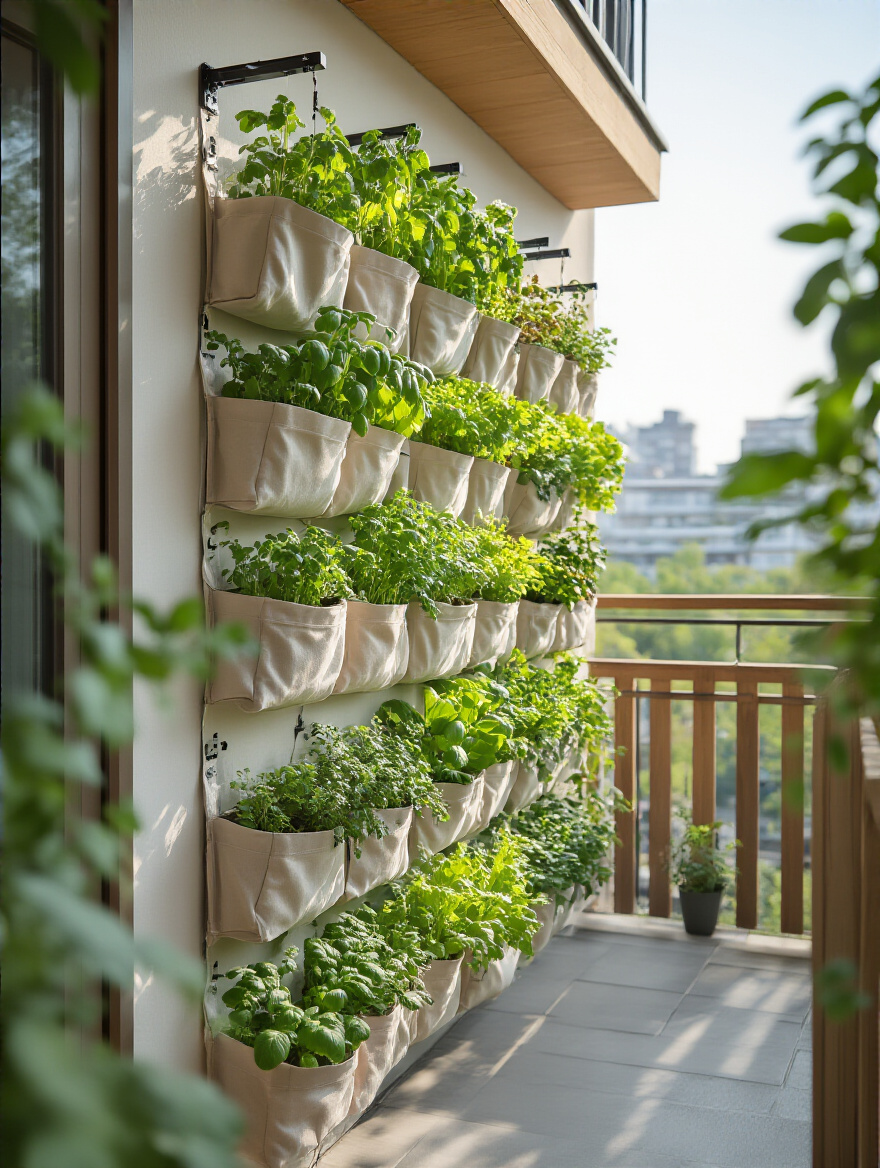
There are so many options available now, from simple fabric pockets you can hang on a wall to modular, stackable tower systems. These are perfect for growing herbs, lettuces, and strawberries, allowing you to create an incredibly productive edible garden in a tiny footprint. Using vertical space draws the eye upward, creating an illusion of height and spaciousness. It’s an interior design trick that works wonders outdoors, turning a flat, two-dimensional area into a rich, three-dimensional experience.
Going vertical is the single best way to dramatically increase your growing capacity and the visual impact of your balcony.
12. Master Proper Planting Techniques for Robust Root Development
The moment you transfer a plant to its new home is a critical one. How you handle it can set the tone for its entire life on your balcony. It’s a moment to be mindful and gentle. When you remove a plant from its nursery pot, take a look at the roots. If they are circling tightly in the shape of the pot, the plant is “root-bound.” You need to intervene.
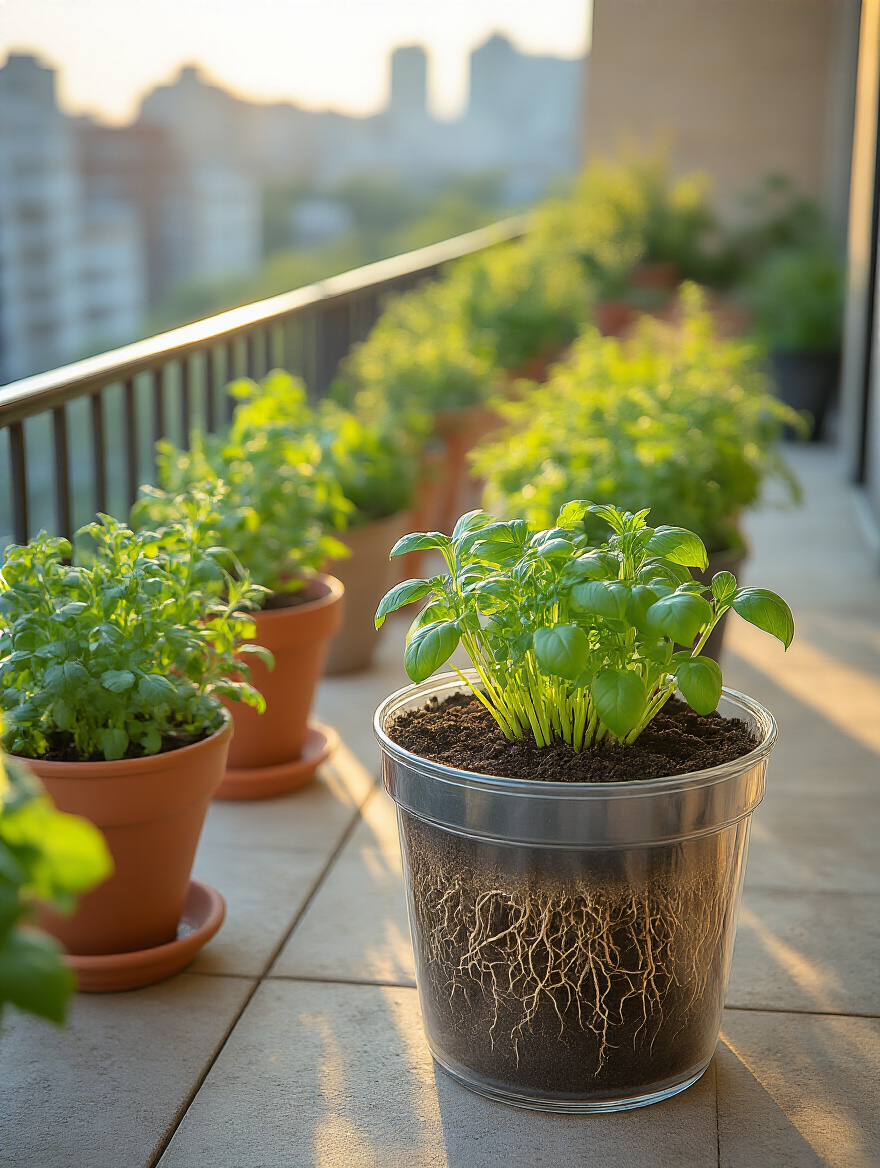
Gently tease the bottom roots apart with your fingers or make a few shallow vertical cuts with a clean knife. This feels aggressive, but it’s crucial. It breaks the “memory” of the old pot and encourages the roots to grow outwards into their new, spacious home. When you place it in the new pot, make sure the top of the root ball is level with the soil line—not too deep, not too shallow. After filling in with soil, press down gently but firmly to remove air pockets. This physical connection—the act of settling a plant into its home—is one of the most grounding and rewarding parts of gardening.
Do this right, and you’re giving your plant the best possible start for a long and healthy life.
Aesthetic Enhancement & Functional Styling: Elevating Your Balcony Oasis (Part 1)
This is where the magic really happens. A healthy garden is wonderful, but a beautifully styled garden is transformative. Now we’ll layer in design principles that will make your balcony feel like a professionally curated space—a true outdoor sanctuary that reflects your personal style.
13. Integrate Decorative Planters for Visual Appeal and Style
Please stop using the flimsy plastic pots your plants come in from the nursery. Planters are not just containers; they are the furniture and art of your outdoor room. Choosing them thoughtfully is one of the most impactful design decisions you can make. A cohesive collection of planters can unify your space, introduce color and texture, and express your personal style. They provide visual structure long after the flowers have faded.

Think about a color palette. A collection of planters in shades of blue, gray, and white can create a serene, coastal feel. Warm terracotta and earthy browns evoke a rustic, Mediterranean vibe. Matte black or sleek metal planters feel modern and architectural. Don’t be afraid to mix materials and textures, but try to stick to a consistent color family to avoid a chaotic look. The planters themselves can be the stars of the show, providing beauty and interest even in the dead of winter.
They are a long-term investment in the style of your space. Choose them with the same care you would a sofa or a piece of art.
14. Utilize Varying Plant Heights and Textures for Dynamic Interest
A balcony filled with plants that are all the same height and have similar leaf shapes is visually boring. It’s like a choir where everyone sings the same note. To create a rich, dynamic, and interesting garden, you need to think like a composer, creating harmony and contrast with different elements. The key is to vary plant height, leaf texture, and shape.
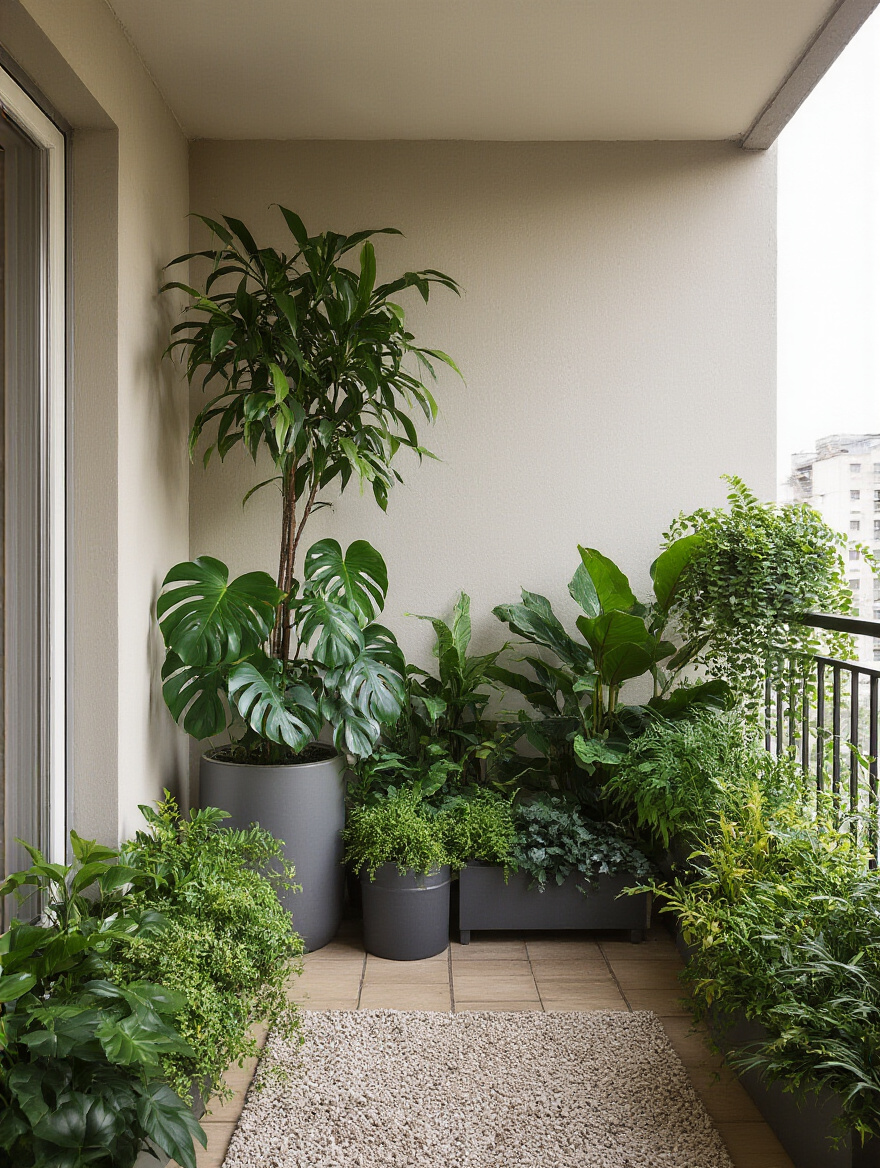
Use the classic design formula: “Thriller, Filler, and Spiller.” For each large container or grouping, choose a tall, dramatic plant (the thriller), several mounding plants to fill in the middle (the filler), and a trailing plant that cascades over the edge (the spiller). This simple recipe creates instant visual hierarchy and depth. And mix up your textures! Pair the bold, broad leaves of a hosta with the delicate, feathery fronds of a fern. Place a spiky, architectural yucca next to a soft, mounding ornamental grass. This textural contrast is what makes a garden feel lush, complex, and alive.
This thoughtful layering is what separates a simple collection of plants from a truly designed space.
15. Incorporate Ambient Lighting for Evening Enjoyment
Why should your beautiful balcony only be enjoyed during the day? With the right lighting, it can transform into a magical, intimate retreat after the sun goes down. Lighting is one of the most powerful tools for shifting the mood of a space. You don’t need complicated wiring; solar-powered options are fantastic and incredibly easy to use.
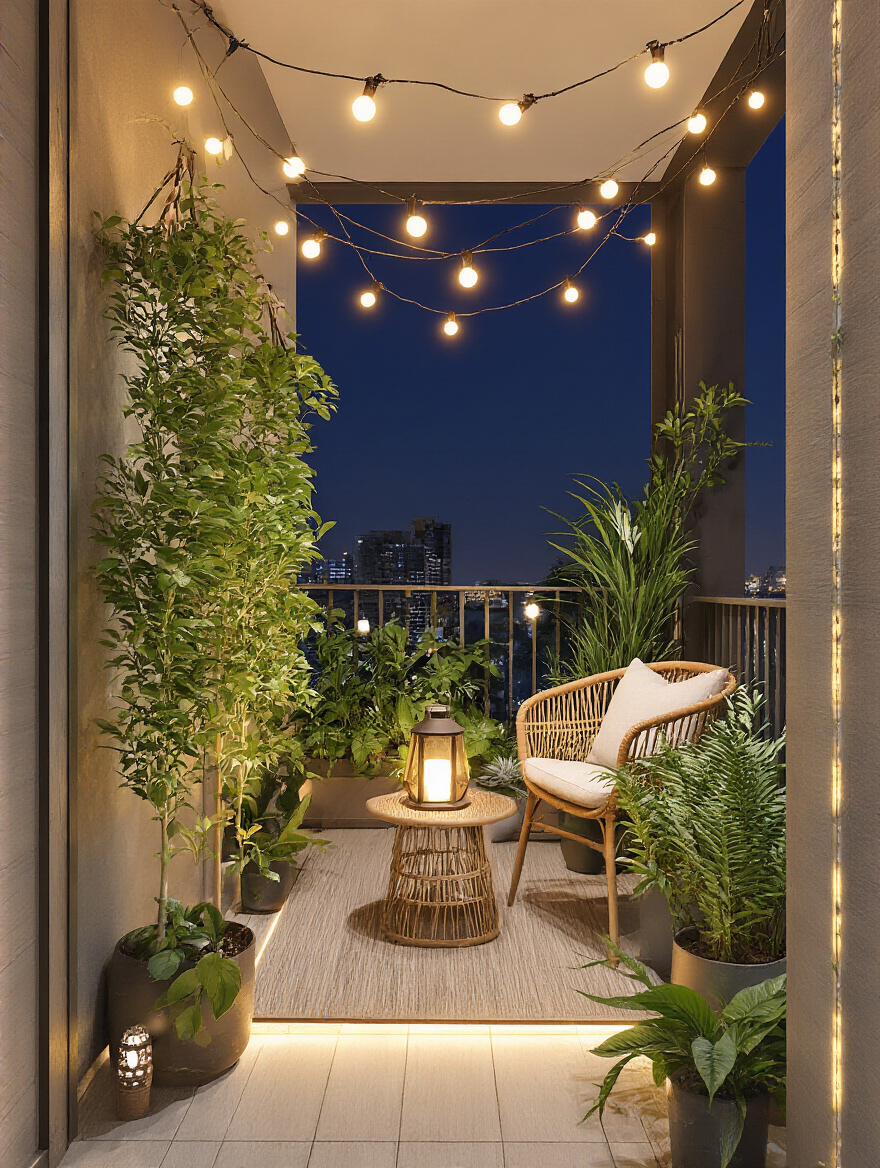
Drape warm, solar-powered string lights along the railing to create a festive, café-like ambiance. Place a few solar-powered spotlights on the floor and aim them up at your most interesting plants, casting dramatic shadows and highlighting their textures. A few rechargeable LED lanterns can provide a soft, portable glow on a side table. The key is to use multiple small sources of warm, gentle light rather than one harsh overhead fixture. This creates pockets of light and shadow, making the space feel cozy, mysterious, and endlessly inviting.
Good lighting can double the amount of time you spend enjoying your outdoor oasis.
16. Grow Edible Herbs and Vegetables for Fresh, Homegrown Produce
There is a unique and profound satisfaction that comes from stepping onto your balcony to snip fresh basil for your pasta or grab a handful of mint for your drink. Growing edibles connects you to your food in a powerful way and elevates your cooking with flavors you simply can’t get from store-bought produce. Many herbs and compact vegetable varieties are perfectly suited for container life.

A small collection of herbs like basil, rosemary, thyme, and mint is easy for beginners and incredibly rewarding. For something more ambitious, look for “patio” or “bush” varieties of tomatoes, cucumbers, and beans that are specifically bred for containers. Integrating edibles doesn’t mean your balcony has to look like a farm. Many herbs and vegetables are beautiful in their own right. A pot of rainbow chard offers stunning color, and the delicate flowers on a basil plant are lovely. It’s the ultimate combination of form and function.
The act of nurturing something that in turn nurtures you back is one of the deepest joys of gardening.
Aesthetic Enhancement & Functional Styling: Elevating Your Balcony Oasis (Part 2)
We’re in the home stretch of the design process. These final touches are about adding architectural interest and a clear sense of purpose to your layout. They provide the structure that supports the wild beauty of the plants themselves, creating a space that feels both lush and intentional.
17. Employ Trellises and Supports for Climbing Varieties
Using trellises to support climbing plants is like hanging art on your walls. It transforms a flat, boring vertical surface into a living masterpiece. A trellis covered in flowering clematis or fragrant jasmine provides not just beauty and scent, but also a sense of enclosure and privacy. It can screen an unsightly view or create the feeling of a secluded garden room, even on a high-rise balcony.
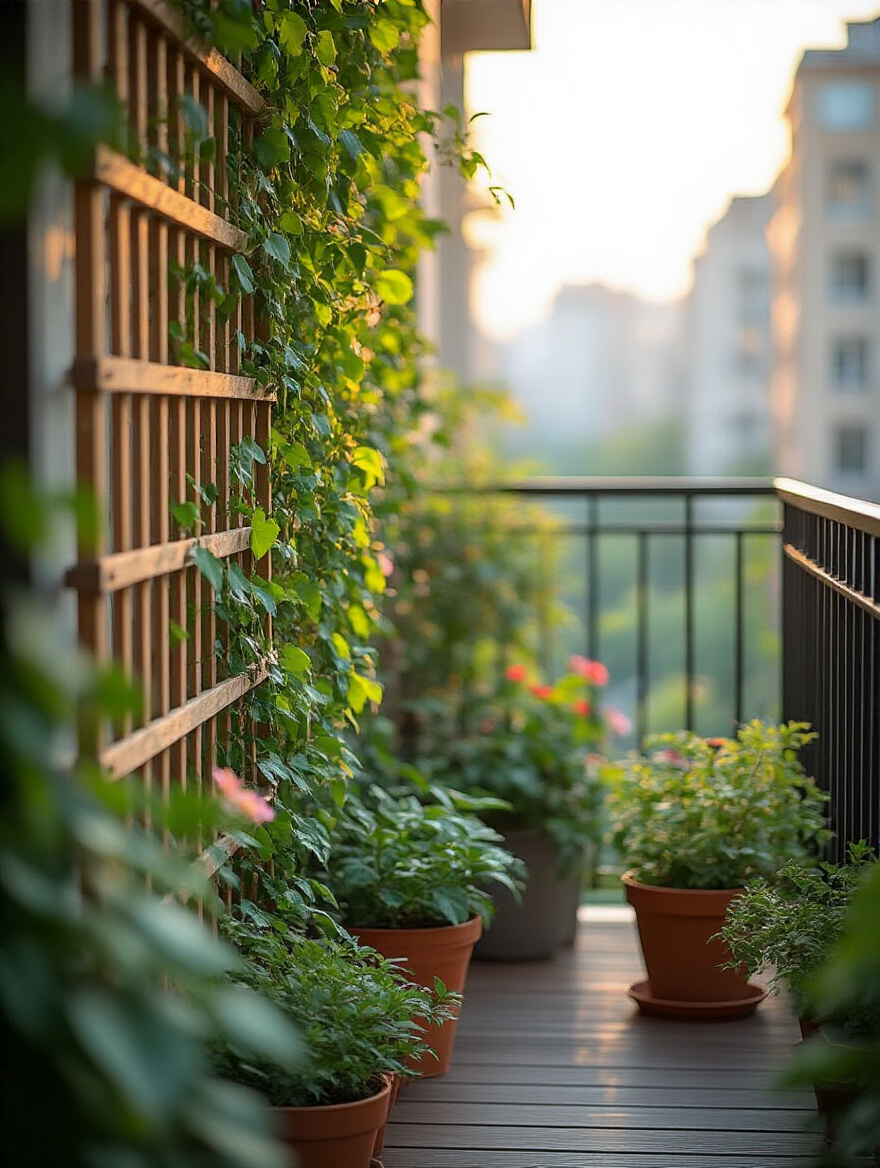
Trellises add architectural interest and structure. You can use a simple grid, an elegant obelisk in a pot, or even create a pattern with wires. This structure is what guides the plant, giving it a framework to grow on and creating a much tidier and more intentional look than a vine left to scramble on its own. It’s an essential tool for maximizing your green footprint and creating a sense of being surrounded by nature.
I’ve seen a simple, narrow balcony transformed into a private grotto with a single well-placed trellis and a climbing rose. The effect is that powerful.
18. Create a Distinct focal point to Draw the Eye
Just like in interior design, every outdoor “room” needs a focal point. It’s a single, dominant element that captures your attention, anchors the design, and gives your eye a place to rest. Without a focal point, a small space filled with many different pots can feel cluttered and chaotic. Creating one brings an immediate sense of order, purpose, and sophistication.
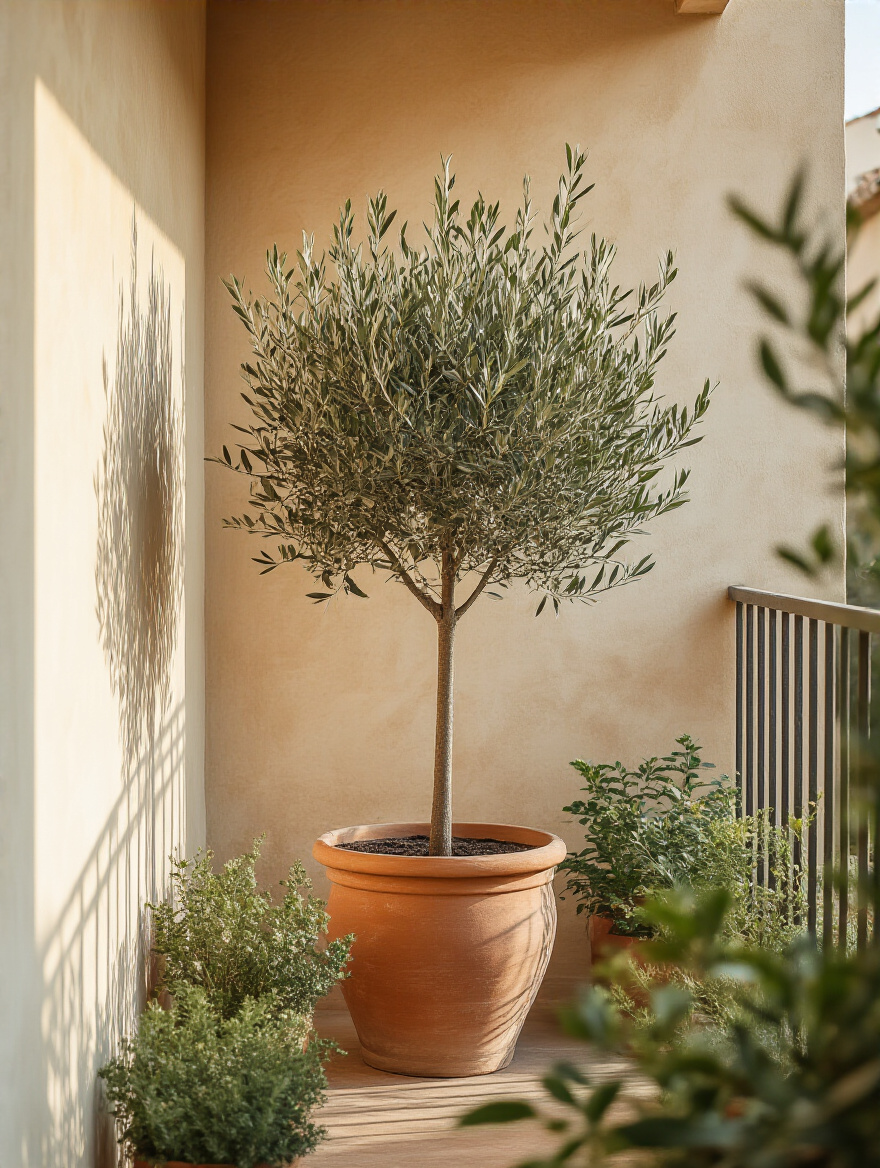
Your focal point could be a single, large, beautiful specimen plant, like a Japanese maple or an olive tree in an impressive pot. It could be a small water feature whose sound adds a layer of tranquility. Or it could be a striking piece of sculpture or a vertically planted wall panel. Whatever you choose, place it in a prominent position where it can be seen from the main vantage point, like the doorway to the balcony. Then, arrange your smaller, supporting plants around it.
This one principle will instantly elevate the design of your balcony from amateur to professional.
Sustained Growth & Expert Maintenance: Nurturing a Lasting Garden (Part 1)
Your beautiful garden is now designed and planted. The final piece of the puzzle is creating simple, sustainable routines to keep it healthy and thriving. Maintenance doesn’t have to be a chore; think of it as a mindful practice, a regular check-in with your little ecosystem.
19. Implement a Consistent Fertilization Schedule for Strong Growth
Plants in containers are living on a limited budget of nutrients. Every time you water, you’re washing a little bit of that nutrition out of the pot. To keep them growing strong, blooming profusely, and resisting pests, you have to replenish their food supply. Think of fertilizer as giving your plants a regular, healthy meal.

A simple, balanced liquid fertilizer, diluted to half-strength and used every couple of weeks during the growing season, is a great place to start. Or, you can mix slow-release granular fertilizer into the soil when you plant, which will feed your plants for several months. The key is consistency. Don’t wait until your plants look pale and sad to feed them. A regular schedule will keep them robust and resilient. Just remember to stop fertilizing in the late fall and winter when most plants go dormant and don’t need the extra food.
This simple routine is a small investment of time that pays huge dividends in plant health and beauty.
20. Proactively Identify and Address Pests and Diseases Early
The best way to deal with pests is to catch them before they become a full-blown infestation. This doesn’t require an expert eye, just a little bit of weekly curiosity. When you’re watering, take a moment to really look at your plants. Check the undersides of leaves, look at the new, tender growth, and peek at the stems. Are there any weird spots? Sticky residue? Tiny webs?
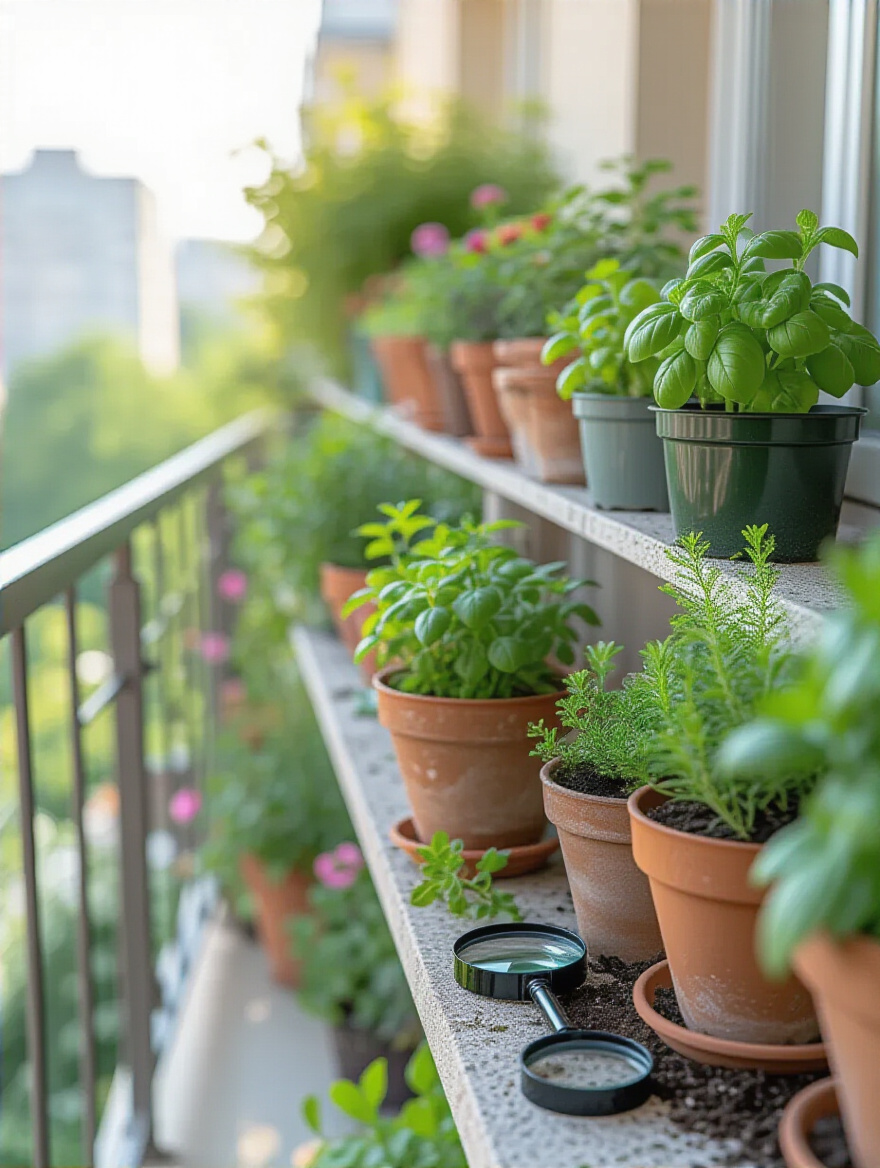
Most common balcony pests, like aphids and spider mites, can be easily handled with a simple spray of insecticidal soap or neem oil if you catch them early. The most important thing you can do is to quarantine any new plants you bring home for a couple of weeks before introducing them to your main collection. New plants are the number one way pests get into your garden. Being a little bit vigilant will save you a world of trouble down the line.
Think of it as a weekly wellness check for your green friends.
21. Master Pruning Techniques for Shape, Health, and Blooms
Pruning can feel intimidating, but it’s one of the most rewarding and creative things you can do for your plants. A good pair of sharp, clean pruning shears is an essential tool. The most basic and impactful type of pruning is “deadheading”—snipping off spent flowers. This does more than just tidy up the plant; it stops the plant from putting energy into making seeds and redirects that energy into making more flowers. It’s the secret to keeping your annuals blooming all summer long.
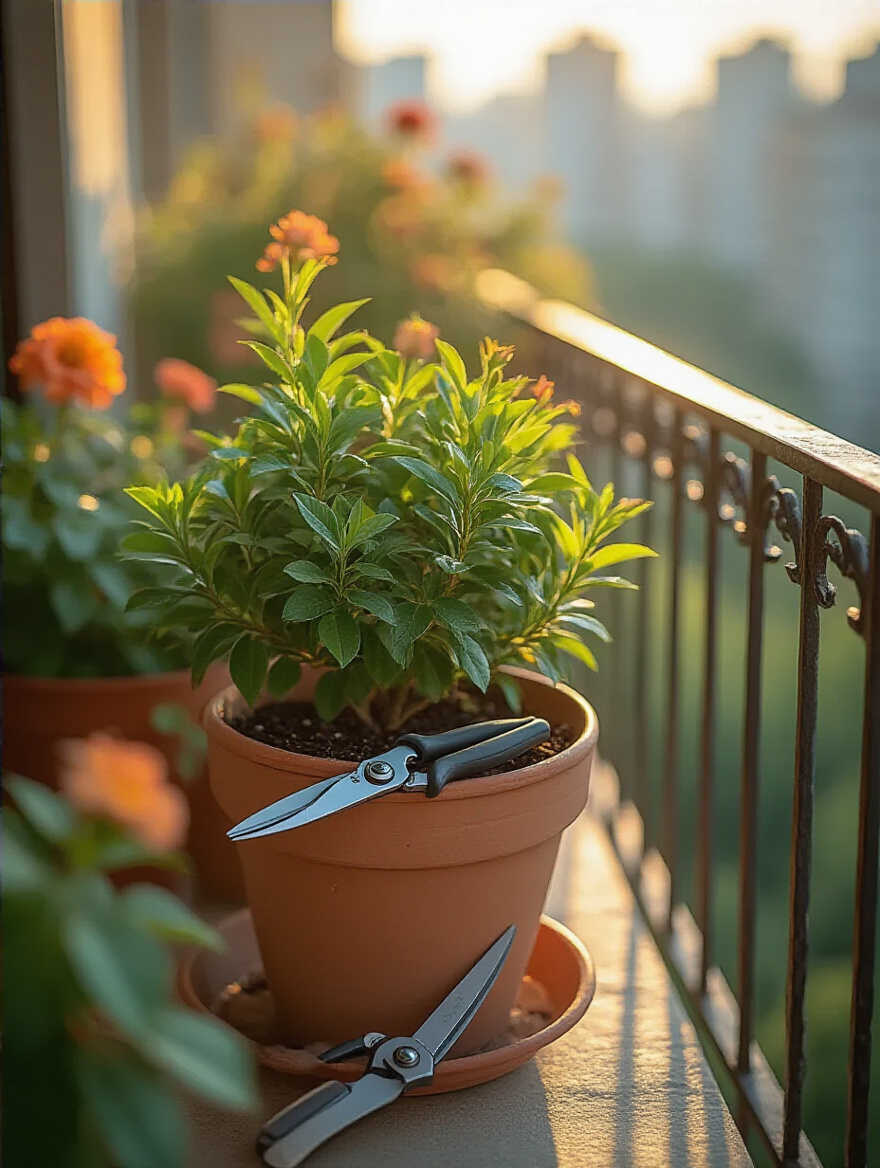
Beyond deadheading, pruning is about shaping your plants, encouraging bushier growth, and removing any dead or diseased branches to keep the plant healthy. A simple “pinch” at the tip of a growing stem on plants like basil or coleus will force it to branch out, creating a much fuller, more robust plant. Don’t be afraid. A good haircut is often exactly what a plant needs to look and feel its best.
Each cut is an intentional act that improves the health and beauty of your garden.
22. Prepare Plants for Seasonal Changes: Winter Protection & Summer Heat
Your balcony garden isn’t a static thing; it lives and breathes with the changing seasons. To ensure its long-term health, you need to help it transition. In summer, this might mean providing some afternoon shade with an umbrella or shade cloth to protect plants from scorching. Dark-colored pots can absorb a lot of heat, literally baking the roots, so you may need to group them together to shade each other or even wrap them in light-colored fabric during a heatwave.
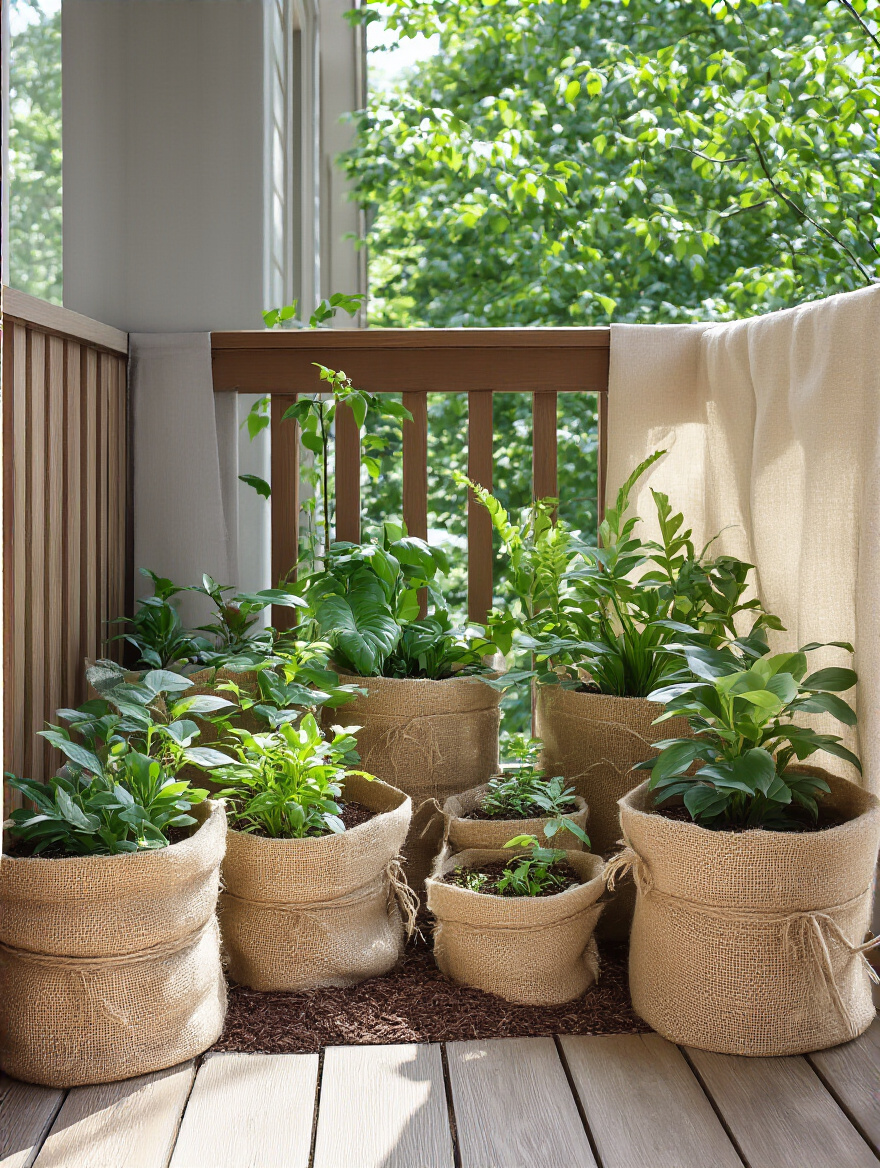
For winter, the biggest danger is the roots freezing. Pot soil freezes much faster and harder than ground soil. Tender plants will need to come indoors. For hardier plants that are staying outside, you can insulate the pots by wrapping them in burlap or bubble wrap. Grouping them together against the wall of your home also helps them share warmth and shields them from harsh winds. Raising pots off the cold concrete with “pot feet” is another simple, crucial trick.
A little bit of seasonal prep ensures you’ll have a healthy garden to welcome you back in the spring.
Sustained Growth & Expert Maintenance: Nurturing a Lasting Garden (Part 2)
As you become a more experienced gardener, you’ll learn to read the subtle signals your plants send. This final part of maintenance is about becoming a good listener—a plant detective who can interpret the clues and respond with the right care.
23. Troubleshoot Common Issues Like Yellowing Leaves or Stunted Growth
A yellowing leaf is not a sign of failure; it’s a message. Your plants are trying to tell you something, and your job is to figure out what it is. Don’t panic and start dumping fertilizer on it. Nine times out of ten, yellow leaves are related to water—either too much or too little. Before you do anything else, stick your finger two inches deep into the soil. What does it feel like? Soggy? Bone dry? This is your most important clue.
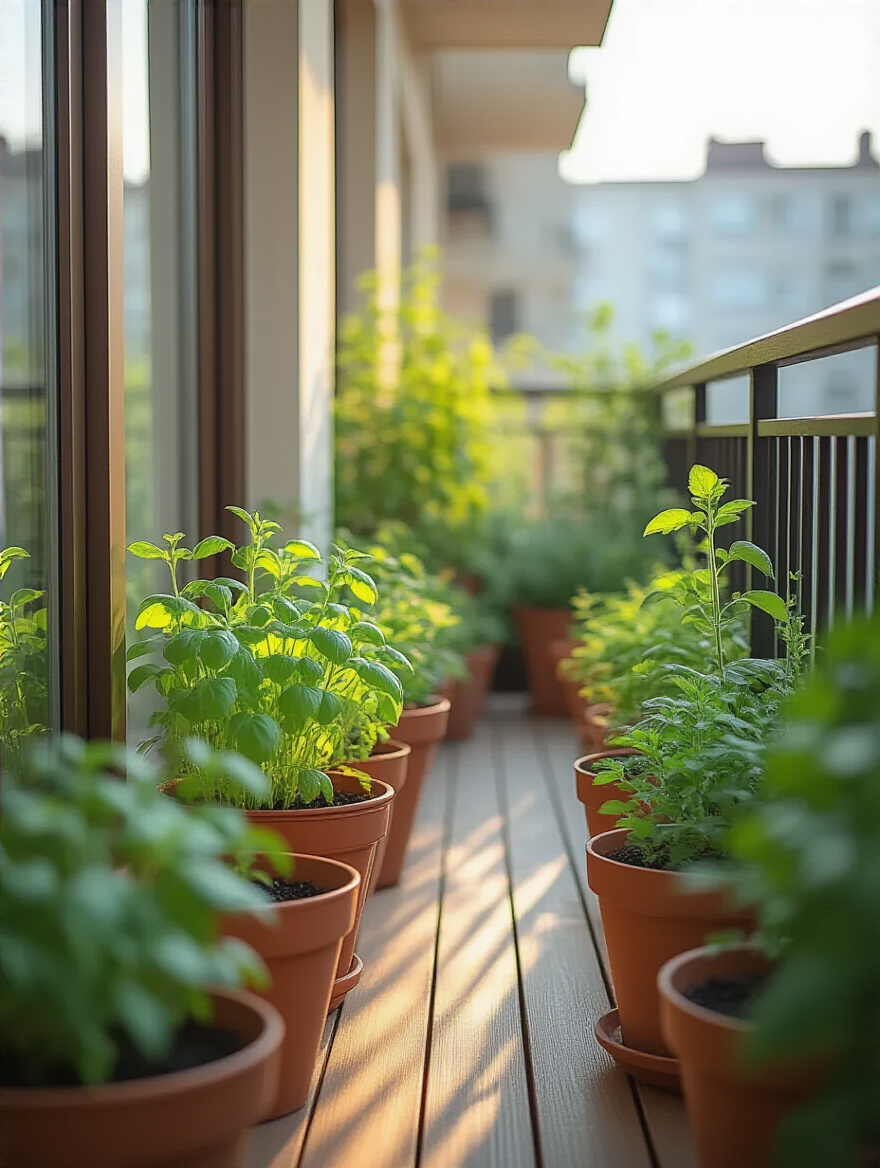
Other issues like stunted growth could be a sign that the plant is root-bound and needs a bigger pot, or that it’s not getting enough light. Use the process of elimination. Check the watering. Check the light. Check the roots. Is it feeding time? By calmly working through the possibilities, you can almost always find the cause. Keep a little journal or use a plant care app to track your actions. You’ll start to see patterns and become much more confident in your ability to diagnose and solve problems.
Becoming a good troubleshooter transforms you from a plant owner into a true plant caretaker.
Conclusion
There you have it. The real framework for creating a balcony garden that is more than just a collection of plants. It’s a designed space, a personal sanctuary, and a source of daily joy and wellbeing. It’s about understanding the science of light and soil, but also the art of color, texture, and mood. By starting with a solid plan, making smart choices, and nurturing your garden with mindful, consistent care, you are setting yourself up for incredible success.
The real magic happens when you step out onto your balcony and feel that wave of calm wash over you. It’s the satisfaction of snipping your own herbs, the quiet pleasure of watching a new leaf unfurl, and the peace of being surrounded by living, breathing beauty that you cultivated yourself. You don’t need a sprawling yard to have a deep connection with nature. You just need a little bit of space, a little bit of knowledge, and the desire to create your own private oasis. So start small, pick one tip, and begin today. Your future self will thank you for it.






